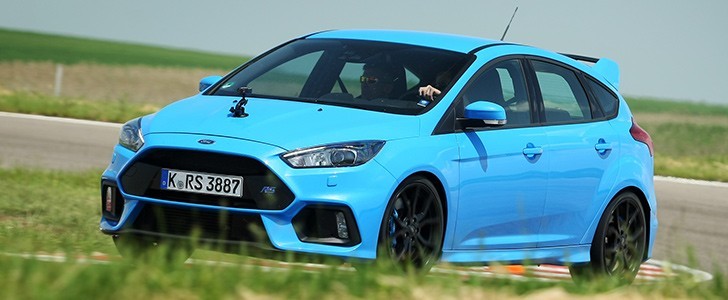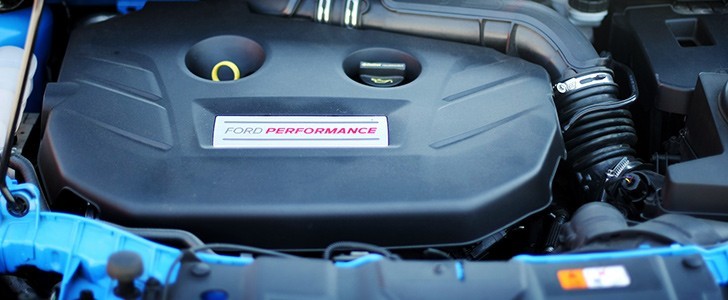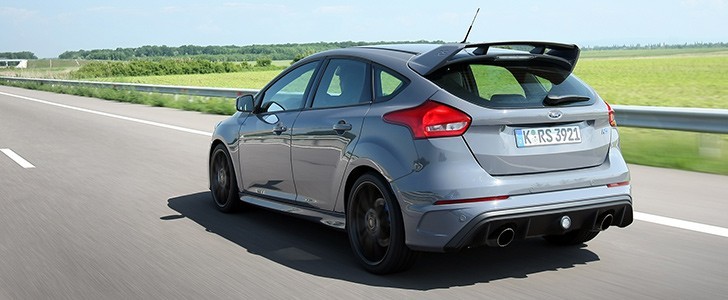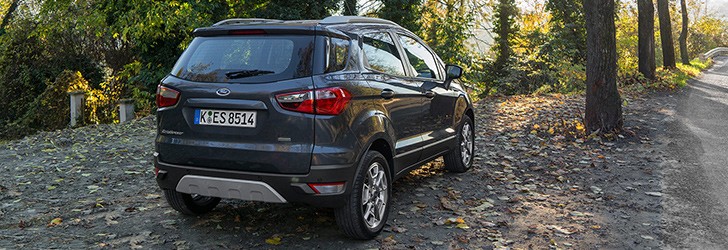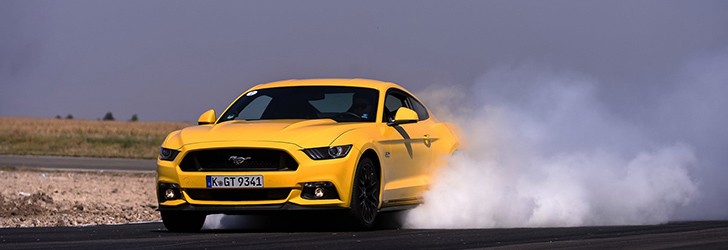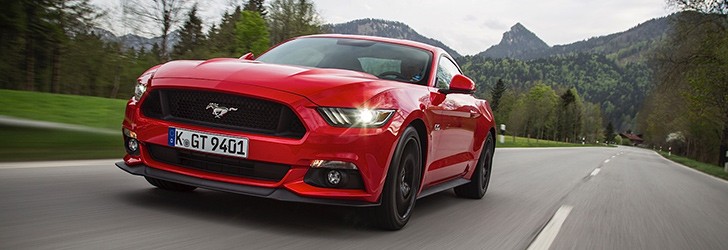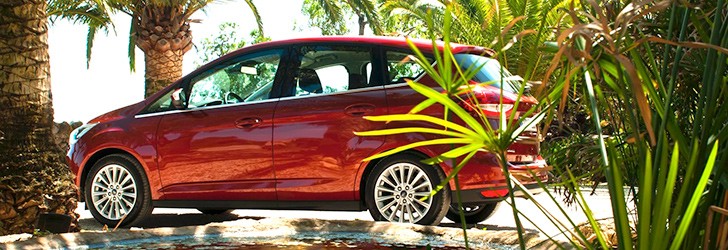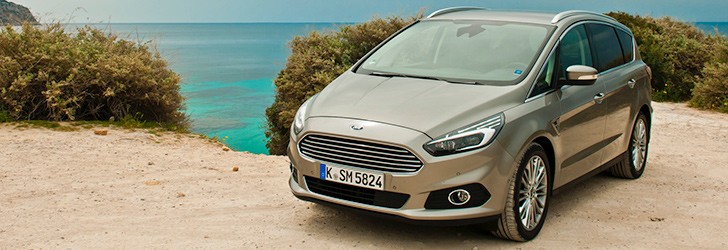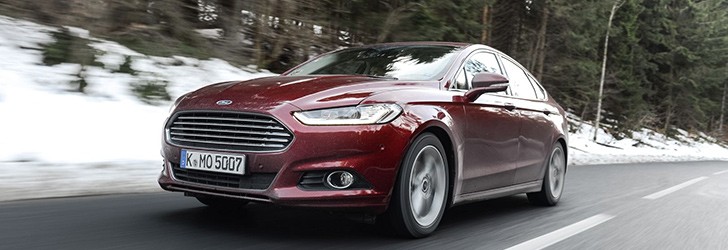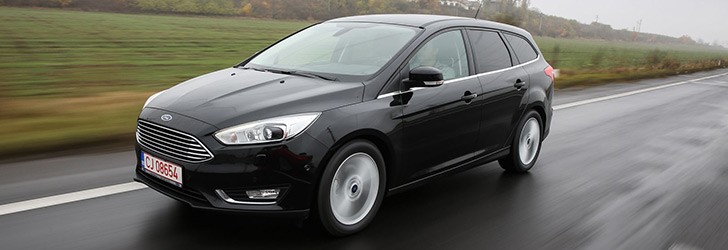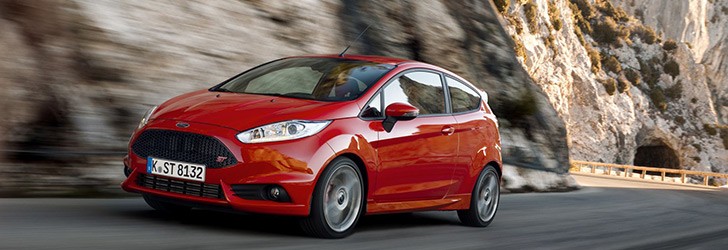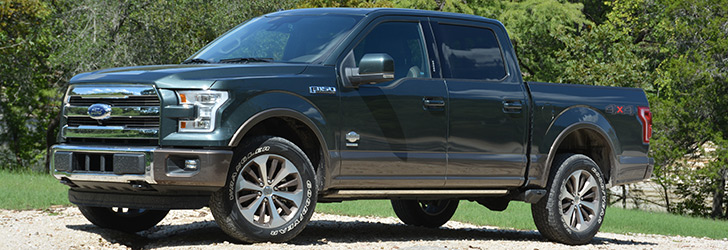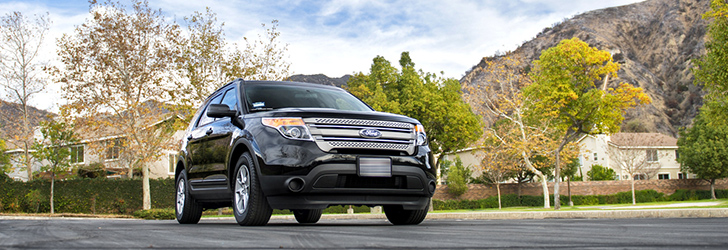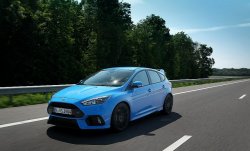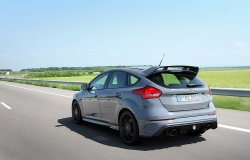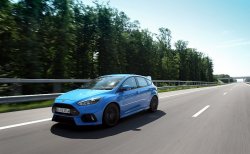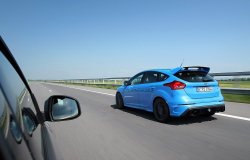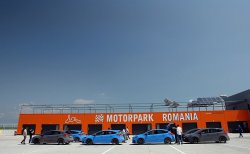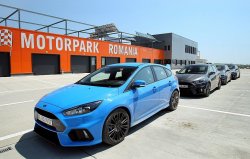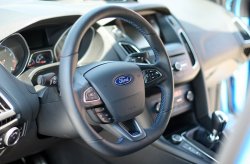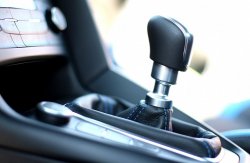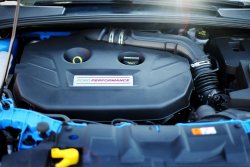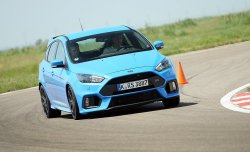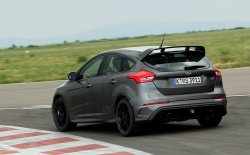2016 Ford Focus RS Review
OUR TEST CAR: 2016 Ford Focus RS
I remember being left speechless after recently seeing a photo of Barack Obama visiting Russia before his first presidential mandate - the then U.S. senator was walking around Red Square without anybody batting an eye. Well, we can almost say the same thing about Ford's RS badge in the U.S., but all that is about to change thanks to the 2016 Focus RS.
While the first two Focus RS generations missing the American market means only a handful of enthusiasts out there know the value of these two letters following a Blue Oval label, the third incarnation of the insane hatch packs all the right assets to bring instant recognition.
After we've recently spent one day inside the third-gen Focus RS, with most of the action taking place on the track, we can safely say this is THE hot hatch of the moment. But we'll get to the comparo part later on, as we'll focus (no pun intended) on the machine itself for this section of the story.
Ford had been working to unify its go-fast divisions for quite some time now, but it wasn't until Ford Performance was created under the helm of Mustang Chief Engineer Dave Pericak that the company managed to achieve this goal. And with the new velocity-dedicated arm having promised us a dozen of performance vehicles through 2020 back in 2015 when the new Ford GT swept Detroit off its feet, the arrival of Focus RS The Third was only natural.
In other words, the car looks just as it drives: fast, but smooth. And while throwing it a glance will instantly set this hot hatch apart from the Focus you rented last holiday, things now seem more organic when compared to the visibly added aggression of the second generation or the rather shy appearance of the first Focus RS.
The press cars we sampled on the test day were split between the extrovert Nitrous Blue and the aptly-named Stealth Gray. And given the balanced appearance of the vehicle, both hues seem to suit the Ford just as well.
We'll quickly go over the part where we discuss the cabin since there aren't too many new elements. In fact, the interior is the weak link of this thrill-deliverer. The obvious issue is one shared by many cars in this segment, namely that the RS badge is mainly highlighted with the help of contrast stitching, the extra instruments adorning the center dash and... well... not much else.
The front seats are obviously also a clue for the tons of added performance, but they make up for the second problem, which is why we're mentioning them separately. Whether you go for the standard Recaros, wich are height-adjustable, or for the optional, fixed-height, Recaro buckets, you'll find yourself sitting too high.
As for the seats themselves, complaining about the hard edges of the optional bucket units would be like having Bud Light and disliking the fact that it's still a little bitter - go for some juice! Alas, the standard seats, which we expected to provide full comfort, feel tight in the side bolster area. Given the fact that they obviously don't provide all the required support on the track, we find this unnecessary.
Our day included around 100 miles (160 km) of road driving to and from the track. With the journey mixing the highway with almost deserted back roads, we got a serious taste of this gym-visiting Focus' street manners.
Given the complex all-wheel drive hardware sending the 350 hp and 350 lb-ft to the road (we'll get to that in a few paragraphs), the driving modes of the car make quite a difference. You get Normal, Sport, Track, as well as Drift.
The rules are simple: on the street, you'll probably stay away from the Track mode as it increases the damper rates by quite a lot (40 percent on the Euro model).
And using the tail-happy mode on public roads is unsafe, as it should be for an electronic nanny that knows how to let you have fun on the track.
While we haven't spent more than a few miles inside the city, the clutch, which is unbelievably friendly for the high-output-AWD setup, means you'll have no issues in your daily driving adventures. As for the six-speed manual, this is decently precise, so while swapping cogs yourself is obviously enjoyable, you'll do this without thinking too much about the hardware.
In fact, the best part of the Mk III Focus RS is its usable lunacy. Not for one moment did we feel more burdened than in your average compact. The steering, for instance, delivers respectable feeling, while becoming invisible during parking maneuvers.
As for the ride and handling balance, the road inconsistencies are always smoothened out, which means your SO won't be able to hold anything against you for buying the RS version instead of the average one. Admittedly, you will have to pay a very small price for this, as the body roll never fully goes away, but this isn't an issue.
It's obvious that Ford Performance engineers have done their homework perfectly when it comes to the handling. Now that the car has gone AWD, the Focus RS comes to top a segment that saw Mitsubishi retiring the Evo and Subaru letting the STI show its age.
Well, Ford's proposal is slotted in between the understeerish nature of the Impreza and the let's-slide-all-day-long attitude of the Lancer. Until you engage Drift mode, that is.
In this setting, the Ford Focus RS will let you achieve delicious slip angles and the best aspect about it is that you never feel the electronics, which are always there, as being intrusive - we're talking about road driving here.
As for our track stint, we were treated with a semi-wet arena where we could slide the RS around in a relatively tight circle. We had to use first gear, which given the fact that the car can hit 62 mph at the top of second gear (in 4.7s), wasn't an issue.
We noticed that while the throttle can take any sort of abuse you can think of with smile-inducing results, you should only use millimetric countersteering. To be more precise, the moment when you flick the wheel the other way, the electronic brain of the AWD steps in and your slide usually comes to an end. In fact, the video below tells the sideways tale rather well.
Oh, and if thought the Focus RS can't take on the Mustang GT in a drifting battle, then you clearly haven't chosen the proper fight.
Drifting is a must nowadays (heck, even the new Prius simulates this in one of its ads), so the Blue Oval simply had to get it right. And it certainly did.
Back on the circuit, the same challenging two-mile (3.3 km) track we used to test the Lamborghini Huracan and the Porsche Cayman GTS, the RS showed a playfully mature attitude.
Using Track Mode, the car corners neutrally, but any bit of understeer that might show up can instantly be corrected. And yes, slight four-wheel sliding moments are entirely normal. But the bottom line is that you can easily reach that point where you fly from one vibrator to another in perfect tune with the car.
The conclusion? The Focus RS is on the hot hatch class podium when it comes to lap times, but it clearly dominates its competitors regarding driving excitement. Poker face or sliding ace, this machine lets you choose the way.
And the mechanical marvel that makes all this possible comes in the form of a GKN-supplied all-wheel-drive system. This is the shiniest part of the car, owing most of the credit to the Torque Vectoring Rear Drive Module (friends call it RDM). This sees a clutch pack being placed on each side of the rear diff, thus being able to transfer up to 100 percent of the rear axle power to any of the wheels - Ken Block approves of this. The transfer is made within .06 seconds by the computer deciding to open or lock the clutch packs.
As for the torque split between the two axles, this is handled by a Power Distribution Unit, which can direct up to 70 percent of the motivation to the rear, but will also disconnect this axle during highway cruising for efficiency gains. The system has just one drawback, one that strongly contributes to the RS blushing when asked to hit the scales - the hatchback comes with a meaty curb weight of 3,525 lbs (1,600 kg).
The generously-sized Brembo brakes fall into the same category as the steering, meaning they're just as good as you'd expect them to be.
Complaints? Our only one has to do with the lack of outright insane behavior at the limit. Then again, Ford has already been spied working on a more aggressive RS derivative (RS500), so this is a feature, not a bug. After all, you can't expect to have the asset mentioned above in the same package as ease of driving at full throttle.
For track addicts, Ford offers optional forged wheels and barely street-legal Michelin Pilot Sport Cup 2 rubber, but we didn't get to put this setup to the test.
If you're looking for even spicier sensations, the considerably more expensive Mercedes-AMG A45 will deliver them, but the Affalterback compact easily falls behind the Ford when it comes to drifting.
There's also the BMW M135i, and while its RWD setup disappointed us by not being precise enough, the xDrive AWD version is just as tail-happy as the Ford. Then again, the M Performance machine is also more expensive, while its straight-six gives it a refined character that doesn't invite the driver to act like a mad man in the way most hot hatches do, Focus RS included.
Moving into the FWD part of the segment, the Honda Civic Type R also feels more hardcore than the Focus RS when in maximum attack mode. Then again, the JDM delight can't match the Focus' pace in the wet, while it's also clearly behind on the refinement front.
We have to admit the overly focused Megane RS might be able to slide to angles just as crazy as the Focus RS, but the cabin and features of the Renault will make the otherwise average interior of the Ford seem like a delight.
The SEAT Leon Cupra? An awesome piece of machinery, whether on the road or on the Nurburgring, but not as complete as this Ford.
On the street is where this car shines to its full potential. While on the track the 2.3-liter EcoBoost seems to lose a bit of its force once you pass 90 mph (150 km/h), you can fully enjoy its 350 horses and 350 lb-ft (474 Nm) on the road. And no, we didn't get to sample the 165 mph (265 km/h) top speed of the vehicle.
As Mustang fans have noticed, the four-cylinder mill has been beefed-up compared to the 310 hp it delivers on the pony car. The upgrade consists of a new twin-scroll turbo with a larger compressor. Ford knows hot hatches get more hooning time than EcoBoost Mustangs, which is why the less restrictive intake and exhaust are matched by a larger intercooler and engine compartment ventilation has been a top priority. Even the block and the cylinder head are slightly revised, using stronger materials.
Burry the throttle and you'll notice the Focus RS pulls well from below 2,000 rpm to its 6,800 rpm rev limit so other drivers won't be able to catch you out too quickly.
Unfortunately, the Focus RS has also inherited the speaker-generated engine noise sound from the Mustang EcoBoost. Inside the car, the resulting soundtrack is decent, but all the engine revving DJ mixing can't match the powers of a mechanical resonator channeling actual engine noise into the vehicle.
The Mk II Focus ST used such a device, with the valve-actuated sound symposer being present on both the pre- and the facelift models. And the same can be said about the Mk II Focus RS. However, with the pre-revamp MK III Focus ST's valve-and-resonator system experiencing reliability issues, the automaker switched to a digital system from the facelift (the current model) onwards.
Take a good look at the tail of the 2016 Focus RS and you'll notice there's a valve right before the exhaust tips. This is there to control the sound and ensure the backpressure is also in check, but the resulting soundtrack only gets a, say, six out of ten in our book. Tuners will undoubtedly correct this, though. And perhaps so will Ford, once its Performance arm gets to introduce an extreme parts catalog as other German automakers do.
Thanks to all the research Ford has done, the Mk III Focus RS feels like an extremely well-mannered hot hatch, but one that wears an ankle revolver under its balanced attire. Make that a pair of revolvers and add some stunning dancing moves, too.
This is the perfect daily driver and a car that will also bring you the laurels on the track, while mirroring its performance in the looks department. More importantly, the new Focus RS will keep your smiling no matter what type of scenery you throw at it.
As for the biggest problem of this Ford, the interior, with its bland appearance and its high driving position, gets this title.
A bit of a bargain? Given all the assets of this Ford, it's hard not to call it so. The 2016 Ford Focus RS comes with an MSRP of $35,900, but you'll have to plan things well ahead due if you're willing to buy one, and that's due to the limited availability. Here's an interesting example: Iceland has just one 2016 Focus RS so far, which happens to be a taxi.
Over in Germany, the manic Focus adventure kicks off at €40,000, including 19 percent VAT.
When it comes to the Euro landscape, the new Focus RS is (we'll say it again) THE hot hatch of the moment. End of story.
As for the American market, you might be tempted to think that the lack of a proper hot hatch background could cause the Ford to lose some traction. But you'd be wrong - when a Focus borrows the EcoBoost Mustang's turbo four but comes with V8 Mustang performance and pricing, the five-door needs no other introduction to stand out.
After we've recently spent one day inside the third-gen Focus RS, with most of the action taking place on the track, we can safely say this is THE hot hatch of the moment. But we'll get to the comparo part later on, as we'll focus (no pun intended) on the machine itself for this section of the story.
Ford had been working to unify its go-fast divisions for quite some time now, but it wasn't until Ford Performance was created under the helm of Mustang Chief Engineer Dave Pericak that the company managed to achieve this goal. And with the new velocity-dedicated arm having promised us a dozen of performance vehicles through 2020 back in 2015 when the new Ford GT swept Detroit off its feet, the arrival of Focus RS The Third was only natural.
When it comes to the appearance of the thing, the 2016 Focus RS is a book that can be judged by its cover.
In other words, the car looks just as it drives: fast, but smooth. And while throwing it a glance will instantly set this hot hatch apart from the Focus you rented last holiday, things now seem more organic when compared to the visibly added aggression of the second generation or the rather shy appearance of the first Focus RS.
The press cars we sampled on the test day were split between the extrovert Nitrous Blue and the aptly-named Stealth Gray. And given the balanced appearance of the vehicle, both hues seem to suit the Ford just as well.
We'll quickly go over the part where we discuss the cabin since there aren't too many new elements. In fact, the interior is the weak link of this thrill-deliverer. The obvious issue is one shared by many cars in this segment, namely that the RS badge is mainly highlighted with the help of contrast stitching, the extra instruments adorning the center dash and... well... not much else.
The front seats are obviously also a clue for the tons of added performance, but they make up for the second problem, which is why we're mentioning them separately. Whether you go for the standard Recaros, wich are height-adjustable, or for the optional, fixed-height, Recaro buckets, you'll find yourself sitting too high.
As for the seats themselves, complaining about the hard edges of the optional bucket units would be like having Bud Light and disliking the fact that it's still a little bitter - go for some juice! Alas, the standard seats, which we expected to provide full comfort, feel tight in the side bolster area. Given the fact that they obviously don't provide all the required support on the track, we find this unnecessary.
Our day included around 100 miles (160 km) of road driving to and from the track. With the journey mixing the highway with almost deserted back roads, we got a serious taste of this gym-visiting Focus' street manners.
Given the complex all-wheel drive hardware sending the 350 hp and 350 lb-ft to the road (we'll get to that in a few paragraphs), the driving modes of the car make quite a difference. You get Normal, Sport, Track, as well as Drift.
The rules are simple: on the street, you'll probably stay away from the Track mode as it increases the damper rates by quite a lot (40 percent on the Euro model).
And using the tail-happy mode on public roads is unsafe, as it should be for an electronic nanny that knows how to let you have fun on the track.
While we haven't spent more than a few miles inside the city, the clutch, which is unbelievably friendly for the high-output-AWD setup, means you'll have no issues in your daily driving adventures. As for the six-speed manual, this is decently precise, so while swapping cogs yourself is obviously enjoyable, you'll do this without thinking too much about the hardware.
In fact, the best part of the Mk III Focus RS is its usable lunacy. Not for one moment did we feel more burdened than in your average compact. The steering, for instance, delivers respectable feeling, while becoming invisible during parking maneuvers.
As for the ride and handling balance, the road inconsistencies are always smoothened out, which means your SO won't be able to hold anything against you for buying the RS version instead of the average one. Admittedly, you will have to pay a very small price for this, as the body roll never fully goes away, but this isn't an issue.
It's obvious that Ford Performance engineers have done their homework perfectly when it comes to the handling. Now that the car has gone AWD, the Focus RS comes to top a segment that saw Mitsubishi retiring the Evo and Subaru letting the STI show its age.
Well, Ford's proposal is slotted in between the understeerish nature of the Impreza and the let's-slide-all-day-long attitude of the Lancer. Until you engage Drift mode, that is.
In this setting, the Ford Focus RS will let you achieve delicious slip angles and the best aspect about it is that you never feel the electronics, which are always there, as being intrusive - we're talking about road driving here.
As for our track stint, we were treated with a semi-wet arena where we could slide the RS around in a relatively tight circle. We had to use first gear, which given the fact that the car can hit 62 mph at the top of second gear (in 4.7s), wasn't an issue.
We noticed that while the throttle can take any sort of abuse you can think of with smile-inducing results, you should only use millimetric countersteering. To be more precise, the moment when you flick the wheel the other way, the electronic brain of the AWD steps in and your slide usually comes to an end. In fact, the video below tells the sideways tale rather well.
Oh, and if thought the Focus RS can't take on the Mustang GT in a drifting battle, then you clearly haven't chosen the proper fight.
Drifting is a must nowadays (heck, even the new Prius simulates this in one of its ads), so the Blue Oval simply had to get it right. And it certainly did.
Back on the circuit, the same challenging two-mile (3.3 km) track we used to test the Lamborghini Huracan and the Porsche Cayman GTS, the RS showed a playfully mature attitude.
Using Track Mode, the car corners neutrally, but any bit of understeer that might show up can instantly be corrected. And yes, slight four-wheel sliding moments are entirely normal. But the bottom line is that you can easily reach that point where you fly from one vibrator to another in perfect tune with the car.
The conclusion? The Focus RS is on the hot hatch class podium when it comes to lap times, but it clearly dominates its competitors regarding driving excitement. Poker face or sliding ace, this machine lets you choose the way.
And the mechanical marvel that makes all this possible comes in the form of a GKN-supplied all-wheel-drive system. This is the shiniest part of the car, owing most of the credit to the Torque Vectoring Rear Drive Module (friends call it RDM). This sees a clutch pack being placed on each side of the rear diff, thus being able to transfer up to 100 percent of the rear axle power to any of the wheels - Ken Block approves of this. The transfer is made within .06 seconds by the computer deciding to open or lock the clutch packs.
As for the torque split between the two axles, this is handled by a Power Distribution Unit, which can direct up to 70 percent of the motivation to the rear, but will also disconnect this axle during highway cruising for efficiency gains. The system has just one drawback, one that strongly contributes to the RS blushing when asked to hit the scales - the hatchback comes with a meaty curb weight of 3,525 lbs (1,600 kg).
The generously-sized Brembo brakes fall into the same category as the steering, meaning they're just as good as you'd expect them to be.
Complaints? Our only one has to do with the lack of outright insane behavior at the limit. Then again, Ford has already been spied working on a more aggressive RS derivative (RS500), so this is a feature, not a bug. After all, you can't expect to have the asset mentioned above in the same package as ease of driving at full throttle.
For track addicts, Ford offers optional forged wheels and barely street-legal Michelin Pilot Sport Cup 2 rubber, but we didn't get to put this setup to the test.
If you're looking for even spicier sensations, the considerably more expensive Mercedes-AMG A45 will deliver them, but the Affalterback compact easily falls behind the Ford when it comes to drifting.
There's also the BMW M135i, and while its RWD setup disappointed us by not being precise enough, the xDrive AWD version is just as tail-happy as the Ford. Then again, the M Performance machine is also more expensive, while its straight-six gives it a refined character that doesn't invite the driver to act like a mad man in the way most hot hatches do, Focus RS included.
Moving into the FWD part of the segment, the Honda Civic Type R also feels more hardcore than the Focus RS when in maximum attack mode. Then again, the JDM delight can't match the Focus' pace in the wet, while it's also clearly behind on the refinement front.
We have to admit the overly focused Megane RS might be able to slide to angles just as crazy as the Focus RS, but the cabin and features of the Renault will make the otherwise average interior of the Ford seem like a delight.
The SEAT Leon Cupra? An awesome piece of machinery, whether on the road or on the Nurburgring, but not as complete as this Ford.
If we had to choose the best setup for the Focus RS, the road, not the track, would be our option.
On the street is where this car shines to its full potential. While on the track the 2.3-liter EcoBoost seems to lose a bit of its force once you pass 90 mph (150 km/h), you can fully enjoy its 350 horses and 350 lb-ft (474 Nm) on the road. And no, we didn't get to sample the 165 mph (265 km/h) top speed of the vehicle.
As Mustang fans have noticed, the four-cylinder mill has been beefed-up compared to the 310 hp it delivers on the pony car. The upgrade consists of a new twin-scroll turbo with a larger compressor. Ford knows hot hatches get more hooning time than EcoBoost Mustangs, which is why the less restrictive intake and exhaust are matched by a larger intercooler and engine compartment ventilation has been a top priority. Even the block and the cylinder head are slightly revised, using stronger materials.
Burry the throttle and you'll notice the Focus RS pulls well from below 2,000 rpm to its 6,800 rpm rev limit so other drivers won't be able to catch you out too quickly.
Unfortunately, the Focus RS has also inherited the speaker-generated engine noise sound from the Mustang EcoBoost. Inside the car, the resulting soundtrack is decent, but all the engine revving DJ mixing can't match the powers of a mechanical resonator channeling actual engine noise into the vehicle.
The Mk II Focus ST used such a device, with the valve-actuated sound symposer being present on both the pre- and the facelift models. And the same can be said about the Mk II Focus RS. However, with the pre-revamp MK III Focus ST's valve-and-resonator system experiencing reliability issues, the automaker switched to a digital system from the facelift (the current model) onwards.
Take a good look at the tail of the 2016 Focus RS and you'll notice there's a valve right before the exhaust tips. This is there to control the sound and ensure the backpressure is also in check, but the resulting soundtrack only gets a, say, six out of ten in our book. Tuners will undoubtedly correct this, though. And perhaps so will Ford, once its Performance arm gets to introduce an extreme parts catalog as other German automakers do.
Thanks to all the research Ford has done, the Mk III Focus RS feels like an extremely well-mannered hot hatch, but one that wears an ankle revolver under its balanced attire. Make that a pair of revolvers and add some stunning dancing moves, too.
This is the perfect daily driver and a car that will also bring you the laurels on the track, while mirroring its performance in the looks department. More importantly, the new Focus RS will keep your smiling no matter what type of scenery you throw at it.
As for the biggest problem of this Ford, the interior, with its bland appearance and its high driving position, gets this title.
A bit of a bargain? Given all the assets of this Ford, it's hard not to call it so. The 2016 Ford Focus RS comes with an MSRP of $35,900, but you'll have to plan things well ahead due if you're willing to buy one, and that's due to the limited availability. Here's an interesting example: Iceland has just one 2016 Focus RS so far, which happens to be a taxi.
Over in Germany, the manic Focus adventure kicks off at €40,000, including 19 percent VAT.
When it comes to the Euro landscape, the new Focus RS is (we'll say it again) THE hot hatch of the moment. End of story.
As for the American market, you might be tempted to think that the lack of a proper hot hatch background could cause the Ford to lose some traction. But you'd be wrong - when a Focus borrows the EcoBoost Mustang's turbo four but comes with V8 Mustang performance and pricing, the five-door needs no other introduction to stand out.
Our FORD Testdrives:
Photo gallery (45)
